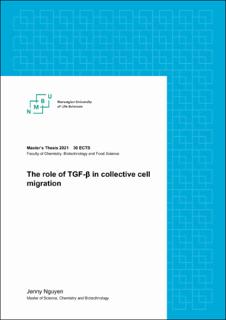| dc.contributor.advisor | Lång, Emma | |
| dc.contributor.advisor | Bøe, Stig Ove | |
| dc.contributor.advisor | Bøhn, Siv Kjølsrud | |
| dc.contributor.author | Nguyen, Jenny Tuyet Mai | |
| dc.date.accessioned | 2021-10-08T10:47:40Z | |
| dc.date.available | 2021-10-08T10:47:40Z | |
| dc.date.issued | 2021 | |
| dc.identifier.uri | https://hdl.handle.net/11250/2788692 | |
| dc.description | This master thesis was conducted within the research group “Experimental Cancer Therapy” led by Stig Ove Bøe at the Department of Microbiology at Oslo University Hospital. | en_US |
| dc.description.abstract | Background: TGF-β is an important growth factor associated with cell growth, cell proliferation, cell differentiation, and apoptosis. TGF-β is also related to the regulation of wound healing and spreading of cancer cells through metastasis, possibly through the transactivation of the EGF/EGFR signaling pathway. The spreading of cancer cells is associated with collective cell migration. Therefore, this master thesis aimed to study the role of TGF-β in collective cell migration, and the intracellular crosstalk between the TGF-β and EGF/EGFR signaling pathways.
Methods: Quiescent confluent monolayers of HaCaT cells were treated with FBS, TGF-β, EGF, and inhibitors of their receptors, SB431542 and Gefitinib, respectively. The magnitude and directionality of collective cell motions were monitored using a high-content ImageXpress Micro Confocal Microscope. The acquired data were further processed by the use of particle image velocimetry (PIV) analysis to generate information on the cell coordination and cell migration velocities.
Results: TGF-β activates cell sheet migration after 15 hours of stimulation, and a lower concentration of TGF-β (5 ng/mL) was more efficient in stimulating cell sheet migration than higher TGF-β concentrations (20-40 ng/mL). Inhibition of the TGF-β signaling pathway in FBS stimulated cell sheets resulted in a slight inhibition of the cell migration response compared to FBS stimulation alone. In contrast, stimulation with FBS combined with TGF-β led to sustained and amplified cell migration response over time. Stimulation with TGF-β produced a lower level of cell coordination (φ) between the migrating cells compared to FBS stimulation, φ = 0.6-0.7 and φ = 0.9, respectively. Notably, TGF-β stimulation alone was not able to transactivate the EGFR cell signaling pathway in this study. However, the results indicate that both signaling pathways are closely connected and produce a different migration response than observed with the two growth factors alone. A combination of TGF-β and EGF stimulation produced a reduction in cell sheet velocities at the earlier time points and enhancement at the later time points.
Conclusion: Our results showed that TGF-β stimulation of quiescent cell sheets does not activate a coordinated collective cell migration response. However, TGF-β does affect the cell sheet migration velocities produced after stimulation together with FBS or EGF. The cell sheet migration response observed was first inhibited and later enhanced during the 30 hours of live cell imaging, indicating intracellular crosstalk between TGF-β and EGF. The crosstalk between these growth factors leads to enhanced p-AKT and cell motility. Therefore, further studies are required in order to acquire a better understanding of how TGF-β regulates collective cell movements. Notably, more insight into the dynamics between the inhibitory and subsequent stimulatory effect of TGF-β on epithelial cell migration is important in the development of improved wound healing and anticancer drug therapies. | en_US |
| dc.description.abstract | Bakgrunn: TGF-β er en viktig vekstfaktor som er assosiert med cellevekst, celleproliferasjon, celledifferensiering og celledød. TGF-β er også relatert til regulering av sårheling og spredning av kreftceller gjennom metastasering, antakelig gjennom transaktivering av EGF/EGFRsignaleringsveien. Spredning av kreftceller er assosiert med kollektiv cellemigrering. Målet med denne masteroppgaven var å studere hvordan TGF-β regulerer cellemigrering, og det intracellulære samarbeidet mellom TGF-β og EGF/EGFR signaleringsveiene.
Metode: Inaktive konfluente monolag av HaCaT-celler ble behandlet med henholdsvis FBS, TGF-β, EGF og inhibitorene SB431542 og Gefitinib. Magnituden og retningen av kollektive bevegelser i cellelaget ble studert ved bruk av et automatisert konfokalt mikroskop, ImageXpress Micro Confocal Microscope. Dataene fra mikroskopet ble prosessert med PIVanalyser for å generere informasjon om koordinasjonen og hastigheten til cellene under
migrering.
Resultater: TGF-β aktiverte cellemigrering etter 15 timer med stimulering, og en lavere konsentrasjon av TGF-β (5 ng/mL) var mer effektiv i å stimulere cellemigrering enn høyere konsentrasjoner (20-40 ng/mL). Inhibering av TGF-β signaleringsveien i FBS-stimulerte celler resulterte i en svak inhibering av cellemigreringen sammenlignet med kun FBS stimulering. Stimulering med FBS kombinert med TGF-β derimot førte til at cellemigreringen ble opprettholdt og forbedret over tid. Stimulering med TGF-β produserte et lavt nivå av cellekoordinering (φ) mellom de migrerte cellene sammenlignet med FBS stimulering, henholdsvis φ = 0,6-0,7 og φ = 0,9. TGF-β aktiverte ikke EGFR signaleringsveien, men resultatene viste at begge signaleringsveiene samarbeidet, og resulterte i en ny migreringsfenotype. En kombinasjon av TGF-β og EGF stimulering førte til en reduksjon i migreringshastigheten på starten, og en forbedret migreringshastighet over tid.
Konklusjon: Resultatene fra forsøket viste at stimulering med TGF-β i inaktive celler ikke førte til aktivering av koordinering eller kollektiv cellemigrering. Migreringshastigheten ble derimot påvirket når cellene var behandlet med TGF-β kombinert med FBS eller EGF. Cellemigreringen ble først hemmet, og deretter stimulert i løpet av 30 timer med «live cell imaging», noe som indikerer intracellulært samarbeid mellom TGF-β og EGF signaleringsveiene. Samarbeidet mellom disse signaleringsveiene fører til økt p-AKT og bedre cellemotilitet. Flere studier er derfor nødvendig for å få en bedre forståelse av hvordan TGF-β regulerer kollektive cellebevegelser. Det er spesielt viktig å få innsikt i dynamikken mellom den inhiberende og stimulerende effekten av TGF-β i epitel cellemigrering, som igjen er viktig for å utvikle legemidler for å behandle kroniske sår, eller medisiner mot kreft. | en_US |
| dc.language.iso | eng | en_US |
| dc.publisher | Norwegian University of Life Sciences, Ås | en_US |
| dc.rights | Attribution-NonCommercial-NoDerivatives 4.0 Internasjonal | * |
| dc.rights.uri | http://creativecommons.org/licenses/by-nc-nd/4.0/deed.no | * |
| dc.title | The role of TGF-β in collective cell migration | en_US |
| dc.type | Master thesis | en_US |
| dc.description.localcode | M-KB | en_US |

